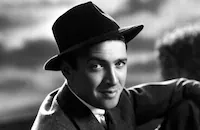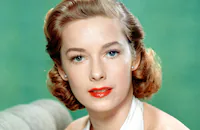The FBI Story

Brief Synopsis
Cast & Crew
Mervyn Leroy
James Stewart
Vera Miles
Murray Hamilton
Larry Pennell
Nick Adams
Film Details
Technical Specs

Synopsis
Before an audience of agency recruits, longtime FBI agent John Michael "Chip" Hardesty relates the history of the agency as he has experienced it: In 1924, before the FBI is actually a government bureau, Chip and his colleague, Sam Crandall, learn that their ineffective and highly politicized organization has a new director, J. Edgar Hoover. That afternoon, Chip proposes to his sweetheart, a pretty Tennessee librarian named Lucy. Before she accepts, she exacts a promise from him that, directly after he meets the new director on their post-honeymoon trip to Washington, D.C., he will resign from the Bureau, which she considers too unrewarding for a brilliant young lawyer like Chip. The newlyweds join Sam on the train to Washington, and are surprised when Sam makes an emotional plea for Chip to remain in the FBI, which he believes could be an effective crime-fighting force under its new leader. Chip is so moved by Hoover's first speech to the agents, an address that demonstrates the director's fire and drive, that he decides to remain in the Bureau for several more years. Disappointed but determined to support her husband, Lucy agrees to the plan, and the next day, the couple is sent south to investigate the terrorist activities of the Ku Klux Klan. On the night Lucy gives birth to their first child, Mike, Chip and Sam finally arrest the Klansmen as they attempt to destroy a newspaper and murder its editor. During the next few years, Chip tackles assignments in various parts of the country while Lucy has two more children, Anne and Jennie. The Hardesty family then settles in Ute City, Oklahoma, as Chip tries to discover who is murdering local Osage Indians, a poor band made suddenly wealthy by the discovery of oil deposits on their land. The Indians fall prey to a veritable circus of salesmen, who peddle everything from patent medicines to casket linings in "official Osage colors." On the night Chip finally arrests white banker Dwight McCutcheon and his nephew for murdering rich Indians and then quietly appropriating their estates, Lucy suffers a miscarriage, and Chip promises to take the family away from "this God-forsaken place." His following assignments take them to the Midwest, where the FBI has begun to track down dangerous gangsters such as Pretty Boy Floyd, Baby Face Nelson, John Dillinger and Ma Barker. After Congress allows the FBI to arm its agents, Sam is killed in a gun battle, leaving a young son named George behind. As the Bureau intensifies its war on the underworld and more agents lose their lives, Lucy's concern for Chip's safety becomes too much for her to bear, and she begs him to resign. When he refuses, she takes the children to live with her parents in Tennessee. Several months pass, and finally, Lucy realizes what her husband and children already know: the family must be reunited. On the very day on which she brings the children home, however, Chip is reassigned and the family moves to Washington, D.C. Years later, during World War II, thousands of agents are accepted into the FBI and instructed to round up "enemy aliens." One of the recruits is Sam's son George, who, while struggling through the Bureau's rigorous training program, becomes seriously involved with Chip's daughter Anne, now an attractive young woman. Young Mike Hardesty joins the Marines and is sent to the Pacific, and Chip is dispatched to Argentina to aid in the interception of coded submarine messages. George is stationed in the jungle there, and he, Chip and a heroic agent named Mario are forced to flee approaching federales . In 1945, the Hardesty family is grieved to learn that Mike has been killed during the landings at Iwo Jima. Following the war, the FBI faces a new threat: international Communism. Using its extensive lab facilities and research capabilities, the FBI tracks down and arrests spies. Chip directs one such case from his desk in Washington. With the help of telephones and radios, the veteran agent coordinates the extended pursuit and ultimate arrest of two New York-based Communist spies. The story of his adventurous life with the FBI over, Chip concludes the day's lecture and joins his waiting family, which now includes a grandson named Mike. Their drive takes them past several of Washington's most famous monuments to freedom, including the sculpture commemorating the landing at Iwo Jima.

Director

Mervyn Leroy
Cast

James Stewart

Vera Miles

Murray Hamilton
Larry Pennell

Nick Adams

Diane Jergens

Jean Willes
Joyce Taylor
Victor Millan

Parley Baer
Fay Roope
Ed Prentiss
Robert Gist
Buzz Martin
Kenneth Mayer
Paul Genge
Michael Garrett
Les Hellman
John Truax
Will J. White
Sid Kane
Gil Smith
Rickey Kelman
Robin Eccles
Dawn Menzer
Kimberly Beck
Jennie Lynn
Michael Switlick
Al Paige
Richard Boyer
Eleanor Audley
John Damler
George Pembroke
Al Tonkle
Rand Harper

Luana Anders
Mary Ann Edwards
Elizabeth Harrower
William J. Thomas
Forrest Taylor
George Selk

Ann Doran
Al Mcgranary
Audley Anderson
Elmore Vincent
Britt Wood
Vera Denham
Fern Barry
Ella Ethridge
David Mcmahon
John Pickard
Tom Monroe
Terry Frost
Harold Mcnulty

Roy Gordon
Rocky Ybarra
Jim Porcupine
Vince St. Cyr
Eddie Little Sky
Chief Yowlachie
Charles Bruner
Dorothy Sky Eagle
Emily All Runner
Charles Soldani
Mary Lou Clifford
Guy Teague
Paul Smith
Kay Kuter
Trippy Elam
Sam Flint
Bob Petersen
Maurice Wells

Mike Smith
Burt Mustin
Guy Wilkerson
William Phipps
Grandon Rhodes
Theona Bryant
Bob Peoples
Scott Peters
Herbert Armstrong
Jack E. Henderson
Jane Crowley
Alan Craig
George Khoury
Angelo Demeo
Stacy Keach
John Quijada
Gabriel Del Valle
James Porta
Paul Denton
Charles Bateman
Arthur Gilmour
Patrick Whyte
Robert Clarke
Ray Montgomery
Nesdon Booth
Jack Tesler
Dorothy Neumann
Ben Erway
Charles Postal
Jerry Brent
William Lovett
Roy Thinnes
Judd Holdren
Morgan Lane
Lowell Brown
Grant Scott
Jeanne Dante
Shirley Bonne
Joan Dupuis
Susan Davis
Barbara Beall
Herman Rudin
Selene Walters
Carroll House
James Vickery
Ed Wagner
John Varnum
Crew
Philip W. Anderson
Gordon Bau
John Beckman
Joseph Biroc
Jack Boland
Richard L. Breen
Florence Crewell
Murray Cutter
Robert Farmer
Ralph Hurst
Irvin Jay
Walter Glen Jones
Gil Kissel
Mervyn Leroy
M. A. Merrick
George Nogle
Adele Palmer
Weldon Patterson
Sergei Petschnikoff
Harlan W. Phillips
Meta Rebner
George Reid
Ann Saunders
Ted Schultz
David Silver
Max Steiner
Kenneth Taylor
John Twist
Bill Walling

Photo Collections
Videos
Movie Clip



Trailer
Hosted Intro
Film Details
Technical Specs

Articles
The FBI Story
By Richard Harland Smith

The FBI Story
Quotes
Trivia
Two F.B.I. agents were on the set at all times.
J. Edgar Hoover personally chose James Stewart for the role of Chip Hardesty because he felt that Stewart conveyed a positive image.
Hoover forced director Mervyn LeRoy to re-shoot a scene because he didn't approve of one of the extras.
Security checks were performed on all those involved on the film's production.
Notes
Part of the "Jack Graham" sequence preceded the opening credits. After the film, a written acknowledgment thanks the FBI and FBI director J. Edgar Hoover for their guidance and participation in the film, and for "making this world of ours a safer place in which to live." According to a September 26, 1959 Los Angeles Times article, The FBI Story was the first film to be made with the full cooperation of the agency. A June 1958 Hollywood Reporter news item reported that the FBI ran "routine checks" on all personnel involved in the film. According to the news item, the agency wanted "no one involved in the production who might later embarrass the F.B.I. by being subsequently revealed as having a commie or criminal past."
A December 1956 Hollywood Reporter news item reported that Warner Bros. had purchased The FBI Story from Pulitzer Prize winner Don Whitehead for "a reported sum well over $100,000." The same item stated that Martin Rackin would produce the picture. Hoover wrote the foreword to the Whitehead book on which the film was based. According to news items, in 1957, Gramercy Pictures bought the rights to a 1950 novel by Mildred and Gordon Gordon, which was also titled The F.B.I. Story, and planned to adapt it for the screen using the same title. Although Gramercy registered the title with the MPAA one week prior to Warner Bros., in November 1958, the MPAA board announced that it was awarding title rights to Warner Bros., who, according to a Variety news item, had the approval of the FBI to use the title. Later, the Gordons filed a plagiarism suit against Warner Bros., claiming that they submitted a script titled F.B.I. Story to the studio before Warner Bros. purchased Whitehead's book. Warner Bros. argued that their film was a documentary based on the Whitehead book, while the Gordons argued that the film was a work of fiction. The Gordons were awarded $54,000 in damages. According to a March 1959 Hollywood Reporter news item, the Gordons later dropped plans to film their novel, became involved with two television productions and bought back their novel from Gramercy.
Portions of the film were shot in Washington, D.C., Quantico, VA and New York City, including the IRT Subway, Yankee Stadium and Central Park. According to a September 1959 Newsweek article, six FBI agents in Los Angeles, New York and Washington, D.C. were used as technical advisors in the film.
In the sequence depicting the capture of John Dillinger, a theater marquee advertises the 1934 M-G-M film Manhattan Melodrama (see AFI Catalog of Feature Films, 1931-40). According to a September 1958 Hollywood Reporter news item, studios usually prefer to highlight their own films in scenes showing marquees, but Warner Bros., for historical accuracy, named the actual film that was shown at Chicago's Biograph Theatre the night the real-life Dillinger was killed.

Miscellaneous Notes
Released in United States 1959
Released in United States on Video Summer 1991
Released in United States 1959
Released in United States on Video Summer 1991
















